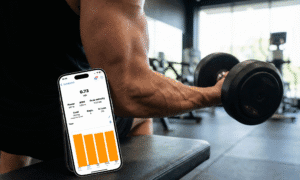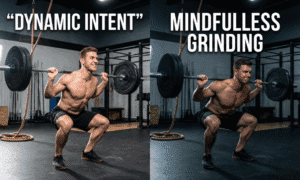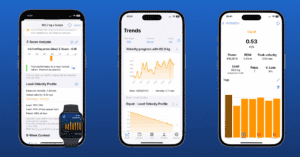Si alguna vez has visto a un atleta esforzarse al máximo en una serie que se suponía iba a ser "explosiva", conoces la frustración. El programa marcaba 80% de 1RM. El atleta hizo los cálculos. La barra se movía como si estuviera clavada en el cemento. Algo claramente no iba bien, pero ¿qué?
Esta es la incómoda verdad que el entrenamiento tradicional basado en porcentajes no quiere que escuches: El 1RM de su atleta fluctúa entre 10 y 20% dependiendo del sueño, el estrés, la nutrición y la fatiga acumulada.¹. ¿Esa carga 80% perfectamente calculada? Podría ser 90% hoy, o 70% mañana. Precisamente por eso los entrenadores que entienden Cómo programar con VBT (El entrenamiento basado en la velocidad) está produciendo atletas que se adaptan más rápido, se mantienen más saludables y rinden cuando importa.
Analicemos exactamente cómo implementar la programación basada en la velocidad en sus sistemas de entrenamiento, utilizando herramientas como Aplicación Spleeft medir y monitorear las métricas que realmente predicen el rendimiento.
¡DESCARGA LA APLICACIÓN SPLEEFT AHORA PARA iOS, ANDROID Y APPLE WATCH!
¿Qué hace que VBT sea diferente de la programación tradicional?
La programación de fuerza tradicional se ha basado en el modelo de porcentaje de 1RM desde la era soviética. Funciona, hasta cierto punto. Pero aquí está la trampa: este enfoque asume que la fuerza máxima es un número fijo que se mantiene constante entre sesiones de prueba¹². En realidad, el 1RM real de un atleta puede variar drásticamente en función de su preparación diaria.
El entrenamiento basado en la velocidad cambia este paradigma al utilizar velocidad de movimiento Como indicador principal de la intensidad del entrenamiento. Cuanto más rápido un atleta mueve una carga dada (con intención máxima), más ligera es esa carga en relación con su capacidad actual. La relación entre carga y velocidad es notablemente consistente y lineal entre los individuos entrenados²³.
La investigación fundamental de González-Badillo y Sánchez-Medina estableció que la velocidad de la barra se correlaciona fuertemente con %1RM en múltiples ejercicios². Esto significa que puedes usar los datos de velocidad para:
Estimar 1RM sin pruebas máximas
Prescribir cargas de entrenamiento basadas en el rendimiento en tiempo real
Monitorea la fatiga y la preparación al instante
Autorregular el volumen dentro de una sesión
Aquí es donde una aplicación como Aplicación Spleeft se vuelve invaluable. En lugar de esperar que sus atletas entrenen con la intensidad adecuada, puede medir su velocidad en tiempo real y tomar decisiones informadas en el momento.
Comprender el perfil de carga-velocidad: su nueva brújula de entrenamiento
Antes de poder programar eficazmente con VBT, necesita comprender los perfil carga-velocidad—la relación individualizada entre el peso en la barra y la velocidad con la que el atleta puede moverla.
Considérelo como la huella digital de su atleta para un ejercicio determinado. Al representarlo en un gráfico, la relación forma una línea casi lineal: a medida que aumenta la carga, la velocidad disminuye de forma predecible²⁴. Este perfil le permite:
Predecir 1RM a partir de cargas submáximas — No es necesario llevar a los deportistas al fallo
Identificar las características de fuerza-velocidad — ¿Su atleta es dominante en la fuerza o dominante en la velocidad?
Seguimiento del progreso a lo largo del tiempo — Un cambio en el perfil indica adaptación
Prescribir cargas con precisión — Apunte a zonas de velocidad específicas para las adaptaciones deseadas
Creación de un perfil de carga-velocidad con la aplicación Spleeft
Para crear un perfil preciso, necesitarás datos de velocidad de 4 a 6 cargas, desde ligeras (~40-50% 1RM) hasta pesadas (~85-90% 1RM)⁵. Aquí tienes un protocolo práctico:
Calentar bien con el ejercicio objetivo
Comience con una barra vacía o una carga ligera. y realizar de 3 a 5 repeticiones con la intención máxima
Añadir peso progresivamente (saltos 10-15%) y registrar la mejor velocidad de repetición en cada carga
Continúe hasta que la velocidad caiga por debajo de ~0,5 m/s (para la mayoría de los ejercicios)
Graficar los datos para visualizar la relación carga-velocidad
La aplicación Spleeft genera automáticamente este perfil mientras entrenas y lo actualiza constantemente según tus datos de rendimiento recientes. La aplicación utiliza tus datos históricos de velocidad para estimar tu 1RM sin necesidad de un intento de máximo real, lo que supone una gran innovación. gestión de atletas salud y preparación para el entrenamiento⁶.
El umbral de velocidad mínima: donde el perfil se encuentra con la realidad
Cada ejercicio tiene un Umbral de velocidad mínima (MVT)—la velocidad más lenta a la que se puede completar una repetición completa. Esta es esencialmente la velocidad a 1RM². Comprender el MVT es fundamental para una estimación precisa de 1RM y la selección adecuada de la carga.
| Ejercicio | Umbral de velocidad mínima (m/s) | Notas |
|---|---|---|
| Sentadilla trasera | ~0.30 | Mayor debido al ciclo de estiramiento-acortamiento²⁷ |
| Press de banca | 0.15-0.17 | MVT más bajo; ROM limitado²⁷ |
| Peso muerto | 0.15-0.25 | Sin SSC; varía considerablemente⁷ |
| Prensa sobre la cabeza | ~0.19 | Entre los valores de sentadilla y press de banca⁵ |
Cuando tu perfil de carga-velocidad se cruza con el MVT, habrás encontrado tu 1RM estimado. La aplicación Spleeft lo calcula automáticamente, brindándote una línea base de fuerza confiable que se actualiza a medida que tu atleta progresa.
Zonas de velocidad: programación para adaptaciones específicas
Una de las aplicaciones más potentes de VBT es la capacidad de apuntar adaptaciones específicas del entrenamiento Al prescribir zonas de velocidad en lugar de porcentajes arbitrarios, diferentes velocidades de movimiento corresponden a diferentes demandas neuromusculares y, en consecuencia, a diferentes resultados de entrenamiento⁸⁹.
| Zona de entrenamiento | Rango de velocidad (m/s) | Aprox. %1RM | Adaptación primaria |
|---|---|---|---|
| Fuerza absoluta | < 0,50 | ≥ 80% | Fuerza máxima, eficiencia neuronal |
| Fuerza acelerativa | 0,50 – 0,75 | 65-80% | Producción de fuerza, reclutamiento de unidades motoras |
| Fuerza-Velocidad | 0,75 – 1,00 | 50-65% | Potencia de salida, fuerza explosiva |
| Velocidad-Fuerza | 1.00 – 1.30 | 35-50% | Tasa de desarrollo de la fuerza |
| Velocidad inicial | > 1.30 | <35% | Capacidad reactiva, potencia balística. |
Cómo utilizar las zonas de velocidad en la práctica
Digamos que estás trabajando con un jugador de voleibol que necesita mejorar el salto Rendimiento. La programación tradicional podría indicar "5×5 a 75%", pero eso no dice nada sobre el estímulo de entrenamiento real.
Usando zonas de velocidad con la aplicación Spleeft, puedes programar:
Bloque de desarrollo de potencia:
Sentadilla trasera: 4×3 a 0,75-0,90 m/s (zona de fuerza-velocidad)
Salto con barra trampa: 4×3 a >1,0 m/s (zona de velocidad-fuerza)
El atleta calienta, encuentra la carga que lo coloca en la zona de velocidad objetivo y entrena allí. Si está fatigado y la velocidad cae por debajo de la zona, se reduce la carga o se termina la serie. Si está fresco y la velocidad es demasiado alta, se añade peso. La zona de velocidad garantiza la adaptación prevista, independientemente de las fluctuaciones diarias en la fuerza absoluta.
Umbrales de pérdida de velocidad: la forma más inteligente de gestionar la fatiga
Quizás ningún concepto en la programación VBT ha generado más interés de investigación que pérdida de velocidad—la disminución de la velocidad de la barra a lo largo de las repeticiones de una serie. Esta métrica proporciona una ventana en tiempo real sobre la acumulación de fatiga y la proximidad al fallo¹⁰¹¹.
La investigación pionera de Pareja-Blanco y sus colegas demostró que la magnitud de la pérdida de velocidad experimentada durante una serie es una variable crucial que determina los resultados del entrenamiento¹⁰. Esto es lo que demuestra la evidencia:
| Pérdida de velocidad | Proximidad al fracaso | Efecto primario | Nivel de fatiga | Mejor para |
|---|---|---|---|---|
| 0-10% | Muy lejos (5-8 RIR) | Adaptaciones neuronales | Mínimo | Atletas de potencia, en temporada¹² |
| 10-20% | Lejos (3-5 RIR) | ganancias de fuerza | Bajo | Fuerza general¹⁰ |
| 20-30% | Moderado (2-3 RIR) | Equilibrado | Moderado | Fuerza e hipertrofia¹³ |
| 30-40% | Cerrar (1-2 RIR) | Hipertrofia | Alto | Fases de desarrollo muscular¹⁴ |
| > 40% | Cerca del fracaso | Resistencia | Muy alto | Resistencia muscular¹⁴ |
La aplicación práctica
Aquí es donde Cómo programar con VBT Se vuelve realmente emocionante. En lugar de prescribir un número fijo de repeticiones, se puede establecer un umbral de pérdida de velocidad y dejar que la preparación diaria del atleta determine el volumen.
Protocolo de ejemplo:
Ejercicio: Sentadilla trasera
Carga:Primera repetición a ~0,65 m/s
Umbral de pérdida de velocidad: 20%
Conjuntos: 4
El atleta realiza repeticiones hasta que la velocidad baja a ~0,52 m/s (pérdida de 20% desde 0,65), y luego detiene la serie. En un buen día, podría hacer 6 repeticiones. En un día más duro, quizás 4. En cualquier caso, El estímulo de fatiga es equivalente—Y ese es el punto.
La app Spleeft facilita esto mostrando las zonas de pérdida de velocidad en tiempo real. Tú estableces tu umbral y la app te indica cuándo parar. Se acabaron las repeticiones agotadoras que hacen más daño que bien.
Cuatro métodos de programación probados con VBT
Ahora, vayamos al grano. Existen varios métodos basados en la evidencia para... Cómo programar con VBT, cada una con distintas ventajas dependiendo de su contexto y objetivos¹⁵.
Método 1: Basado en porcentajes con retroalimentación de velocidad
Este es el punto de acceso más accesible a la VBT. Los atletas siguen las prescripciones tradicionales de %1RM, pero reciben retroalimentación de velocidad para mejorar la intención y monitorear la preparación¹⁵.
Ejemplo: 4×5 a 80% 1RM con seguimiento de velocidad
Ventajas:
Estructura familiar para entrenadores y atletas.
Los datos de velocidad revelan si las cargas son apropiadas
Crea una base de datos histórica para programación futura
Cuándo usarlo:Presentación de VBT a un equipo, en las primeras fases de la temporada baja o cuando desea datos de velocidad sin revisar su sistema actual.
Método 2: Prescripción de zona de velocidad
Prescribir una zona de velocidad objetivo en lugar de un porcentaje. Los atletas calientan para encontrar la carga que produce la velocidad deseada y entrenan con esa carga¹⁵.
Ejemplo: 4×3 a 0,50-0,65 m/s (zona de fuerza acelerativa)
Ventajas:
Se ajusta automáticamente a la preparación diaria.
Garantiza un estímulo de entrenamiento preciso
Elimina las conjeturas en la selección de carga
Cuándo usarlo:Entrenamiento por fases específicas, cuando se buscan adaptaciones particulares o con atletas que tienen perfiles de carga-velocidad establecidos.
Método 3: Puntos de corte de pérdida de velocidad
Las series finalizan cuando la velocidad disminuye en un porcentaje predeterminado desde la repetición más rápida, lo que controla la fatiga y la calidad de la repetición¹⁰¹⁵.
Ejemplo: 4 series a una velocidad inicial de 0,55 m/s, límite de pérdida de velocidad 20%
Ventajas:
Autorregula el volumen en función de la fatiga.
Previene el volumen basura
Conserva la calidad de la repetición durante toda la sesión.
Cuándo usarlo:Entrenamiento durante la temporada, fases de desarrollo de potencia o cuando la gestión de la fatiga acumulada es fundamental.
Método 4: Repeticiones indeterminadas dentro del rango de velocidad (AMRAP)
Los atletas realizan tantas repeticiones como sea posible, manteniéndose dentro de un rango de velocidad definido. La serie finaliza cuando la velocidad desciende por debajo del umbral inferior¹⁵.
Ejemplo:AMRAP a 0,45-0,60 m/s
Ventajas:
Maximiza el volumen efectivo
Autorregulación en función de la capacidad diaria
Excelente para monitorear la capacidad de trabajo a lo largo del tiempo.
Cuándo usarlo:Fases de preparación general, creación de capacidad de trabajo o cuando se desea obtener el máximo volumen productivo.
Implementación de VBT con la aplicación Spleeft: un flujo de trabajo práctico
Veamos cómo un entrenador podría implementar Programación VBT utilizando la aplicación Spleeft durante una semana de entrenamiento.
Día 1: Fuerza y potencia de la parte inferior del cuerpo
Objetivo:Desarrollar cualidades de fuerza-velocidad para mejorar la aceleración.
Abrir la aplicación Spleeft y seleccione el perfil del atleta
Calentamiento con sentadilla trasera:Carga progresiva, registro de la velocidad en cada peso
La aplicación actualiza automáticamente el perfil de velocidad de carga.
Monitoree la visualización estimada de 1RM: si es más baja de lo habitual, el atleta puede necesitar ajustes de carga.
Conjuntos de trabajo: 4×4 a 0,55-0,70 m/s con corte de pérdida de velocidad 15%
Spleeft muestra la velocidad en tiempo real y alerta cuando se alcanza el umbral
Si la velocidad se mantiene alta, considere agregar entre 2,5 y 5 kg para las series posteriores.
Saltos con barra trampa: 4×3 a >1,0 m/s
Trabajo puro de velocidad-fuerza; si la velocidad cae por debajo del objetivo, reduzca la carga inmediatamente
Día 2: Fuerza de la parte superior del cuerpo
Objetivo:Desarrolle fuerza de presión con fatiga controlada
Press de banca con carga progresiva:Aumenta el peso hasta alcanzar el peso de trabajo mientras Spleeft rastrea las velocidades
Conjuntos de trabajo: 5×3 a 0,35-0,50 m/s con umbral de pérdida de velocidad 20%
La aplicación muestra que estás en la zona de fuerza acelerada.
La retroalimentación de velocidad confirma que cada repetición está entrenando la calidad deseada.
Revisión de la sesión:Consulta el resumen de la aplicación: repeticiones totales, velocidad promedio, tendencias de pérdida de velocidad
Comparar con sesiones anteriores para monitorear el progreso
Revisión semanal
Al final de la semana, revise el panel de control en la aplicación Spleeft:
Estimaciones de 1RM¿Tienen tendencia al alza?
Velocidades de entrenamiento promedio¿Los atletas mantienen la velocidad con cargas similares?
Patrones de pérdida de velocidad¿Existen señales de alerta que indiquen fatiga acumulada?
Este enfoque basado en datos transforma la programación de conjeturas fundamentadas a entrenamiento de precisión—Y ese es el verdadero poder de la comprensión. Cómo programar con VBT.
Autorregulación y preparación diaria: la ventaja del VBT
Uno de los aspectos más valiosos de VBT es su capacidad para autorregulación—ajustar las cargas y volúmenes de entrenamiento en función de indicadores de rendimiento en tiempo real¹⁶¹⁷.
Los programas tradicionales asumen que el martes siempre será un buen día para hacer sentadillas pesadas. La realidad no funciona así. La falta de sueño, el estrés psicológico, los viajes y la vida fuera del gimnasio afectan el rendimiento.
Las investigaciones demuestran que la velocidad es más sensible a los cambios de preparación que la carga levantada o el RPE¹⁷. Un atleta podría alcanzar sus cifras prescritas en un día de baja preparación, pero el desgaste repeticiones lentas revelan que están trabajando mucho más duro de lo previsto.
Uso de la aplicación Spleeft para supervisar la preparación
La aplicación Spleeft compara la velocidad de tu sesión actual con tu promedio histórico para la misma carga. Aquí te explicamos cómo interpretar los datos:
Velocidad > 5% por encima del promedio:Alta disponibilidad: considere agregar carga o volumen
Velocidad dentro de 5% del promedio:Disposición normal: proceder según lo planeado
Velocidad 5-10% por debajo del promedio:Fatiga moderada: considere reducir la carga en 5%
Velocidad > 10% por debajo del promedio:Baja preparación: reducir el volumen y la intensidad, centrarse en la recuperación
No se trata de mimar a los atletas. Se trata de... entrenamiento inteligente. El objetivo es una sobrecarga progresiva a lo largo del tiempo, y eso requiere una gestión estratégica de la fatiga dentro de las sesiones individuales y a lo largo de los ciclos de entrenamiento.
5 errores comunes al aprender a programar con VBT
Como ocurre con cualquier metodología, existen trampas que hay que evitar:
Error 1: Obsesionarse con los números de velocidad en lugar de la intención
La VBT solo funciona cuando los atletas se mueven con intención máxima². Si se controlan el ritmo o no intentan acelerar la barra, los datos de velocidad no son relevantes. Primero la intención del entrenador, luego la velocidad del seguimiento.
Error 2: Establecer objetivos de velocidad demasiado estrechos
Un objetivo de "exactamente 0,75 m/s" genera estrés innecesario y parálisis de decisión. rangos (0,70-0,80 m/s) que dan cuenta de la variación natural de repetición a repetición.
Error 3: Ignorar las diferencias individuales
Si bien existen estándares de velocidad grupal, cada atleta puede mostrar perfiles diferentes². Algunos se mueven más rápido de forma natural con cualquier carga; otros son muy exigentes. Cree perfiles individuales antes de tomar decisiones de programación.
Error 4: Descuidar el protocolo de calentamiento
Las rutinas de calentamiento constantes reducen la variabilidad de la velocidad y aumentan la fiabilidad de tus datos⁶. Estandariza tu enfoque.
Error 5: Usar VBT sin contexto
Los datos de velocidad no reemplazan el conocimiento del coaching, sino que lo enriquecen. Los números fundamentan las decisiones; no las toman por ti.
Integración de VBT en programas existentes
No es necesario reestructurar todo para beneficiarse de la terapia de reemplazo valvular. Aquí tiene un enfoque gradual:
Fase 1Añade seguimiento de velocidad a tu programa actual. Recopila datos, crea perfiles y aprende los números.
Fase 2: Introducir autorregulación basada en la velocidad. Utilizar umbrales de pérdida de velocidad para determinar el final de las series.
Fase 3: Comience a prescribir ejercicios clave por zonas de velocidad. Mantenga el trabajo porcentual para los accesorios.
Fase 4Integración completa con VBT. Todos los levantamientos principales se programan por velocidad, con datos históricos que determinan la periodización.
La aplicación Spleeft respalda cada fase de este viaje, desde el simple seguimiento de la velocidad hasta el sofisticado Perfiles de velocidad de carga y estimación de 1RM.
El caso de la VBT respaldado por la investigación
La evidencia que apoya la TVC continúa creciendo:
Los metanálisis muestran que la VBT mejora eficazmente fuerza máxima (SMD = 0,76), resistencia a la fuerza (SMD = 1,19), rendimiento de salto (SMD = 0,53), y **capacidad de sprint (SMD = -0,40)**¹⁸.
La retroalimentación de velocidad durante el entrenamiento aumenta la potencia máxima en aproximadamente 8-9% en comparación con condiciones sin retroalimentación¹⁹.
Los umbrales de pérdida de velocidad bajos (10-20%) producen ganancias de resistencia similares o mayores que los umbrales altos, aunque requieren 50% menos repeticiones¹⁰¹².
VBT permite una estimación de 1RM más segura, especialmente valiosa para Atletas jóvenes y protocolos de regreso al juego²⁰.
En resumen: El VBT no es solo una moda pasajera de entrenamiento. Es una metodología basada en la fisiología del ejercicio y respaldada por una sólida base de investigación revisada por pares.
Preguntas frecuentes
¿Puedo utilizar VBT sin un equipo costoso?
Por supuesto. Si bien los dispositivos de velocidad dedicados ofrecen alta precisión, aplicaciones como Aplicación Spleeft Aproveche los sensores de su smartphone y la integración con el Apple Watch para obtener datos de velocidad fiables a un coste mucho menor. Las investigaciones demuestran que los sistemas basados en smartphones pueden lograr correlaciones superiores a r > 0,95 con el estándar de referencia. transductores lineales Para muchas aplicaciones.
¿Cuánto tiempo se tarda en ver resultados de la programación VBT?
La mayoría de los atletas notan mejoras inmediatas en la calidad del entrenamiento: mayor consistencia en las repeticiones, una selección de carga más adecuada y una retroalimentación más clara sobre el esfuerzo. Las ganancias objetivas de fuerza suelen aparecer entre 4 y 8 semanas después de una implementación constante, similar a los programas tradicionales, pero con mejor... gestión de la fatiga.
¿Es VBT apropiado para levantadores principiantes?
Sí, con algunas consideraciones. Los principiantes suelen carecer de la coordinación motora necesaria para mostrar velocidades constantes al principio de su entrenamiento. Concéntrese primero en desarrollar la competencia de movimiento y luego introduzca el control de la velocidad a medida que la técnica se estabilice. El VBT puede ayudar a los principiantes a aprender los niveles de esfuerzo adecuados al proporcionar retroalimentación objetiva sobre la calidad de sus repeticiones.
¿Cuál es la diferencia entre velocidad media y velocidad máxima?
Velocidad media es la velocidad promedio en toda la fase concéntrica: esta es la métrica más comúnmente utilizada y se correlaciona mejor con la carga relativa. Velocidad máxima Es la velocidad instantánea máxima alcanzada durante la sustentación. La mayoría de las investigaciones y aplicaciones prácticas se basan en la velocidad media o la velocidad propulsiva media (que excluye la fase de desaceleración en sustentaciones no balísticas)².
¿Con qué frecuencia debo volver a probar 1RM cuando uso VBT?
Una de las principales ventajas del VBT es que rara vez necesitas realizar una prueba real de 1RM. Tu perfil de carga-velocidad proporciona una estimación actualizada continuamente basada en datos de entrenamiento submáximo. Es posible que se realicen nuevas pruebas formales cada 8-12 semanas para fines de validación, pero la estimación diaria de la aplicación Spleeft te mantiene informado sin el riesgo de fatiga y lesiones que conllevan los intentos máximos.
Iván de Lucas Rogero
Aplicación de rendimiento físico y CEO de MSC
Dedicado a mejorar el rendimiento atlético y el entrenamiento ciclista, combinando ciencia y tecnología para impulsar resultados.
Referencias
González-Badillo JJ, Sánchez-Medina L, Ribas-Serna J, Rodríguez-Rosell D. Hacia un nuevo paradigma en el entrenamiento de fuerza mediante el monitoreo de la velocidad: una narrativa crítica y desafiante. Abierto Médico Deportivo. 2022;8(1):118.
González-Badillo JJ, Sánchez-Medina L. Velocidad de movimiento como medida de la intensidad de carga en el entrenamiento de resistencia. Int J Sports Med. 2010;31(5):347-352.
Jovanović M, Flanagan EP. Aplicaciones investigadas del entrenamiento de fuerza basado en la velocidad. J Aust Strength Cond. 2014;22(2):58-69.
Sánchez-Medina L, González-Badillo JJ, Pérez CE, Pallarés JG. Estimación de la carga relativa a partir de la velocidad de la barra en el ejercicio de sentadilla trasera completa. Medicina deportiva internacional J. 2017;38(5):370-377.
Guía de perfiles de carga-velocidad. Output Sports. 2024.
Entrenador VBT. Estimación de 1RM con entrenamiento basado en la velocidad: una guía completa. 2024.
Lake J, Naworynsky D, Duncan F, Jackson M. Comparación de diferentes umbrales de velocidad mínima para establecer 1RM en peso muerto. Int J Sports Physiol Perform. 2017;12(10):1316-1323.
MeasureUp. Entrenamiento basado en la velocidad para ganar fuerza: una visión general basada en la evidencia. 2025.
Mann JB. Zonas de entrenamiento basadas en la velocidad y aplicaciones. GymAware. 2025.
Pareja-Blanco F, Rodríguez-Rosell D, Sánchez-Medina L, et al. Efectos de la pérdida de velocidad durante el entrenamiento de resistencia en el rendimiento atlético, el aumento de fuerza y las adaptaciones musculares. Scand J Med Sci Sports. 2017;27(7):724-735.
Suchomel TJ, Nimphius S, Bellon CR, Stone MH. La importancia de la fuerza muscular: consideraciones de entrenamiento. Sports Med. 2018;48(4):765-785.
Rodríguez-Rosell D, Yáñez-García JM, Torres-Torrelo J, et al. Entrenamiento de resistencia basado en la velocidad: impacto de la pérdida de velocidad en la serie sobre el rendimiento neuromuscular y la respuesta hormonal. Appl Physiol Nutr Metab. 2020;45(8):817-828.
Held S, Hecksteden A, Meyer T, Donath L. Efectividad del entrenamiento de fuerza tradicional frente al entrenamiento basado en la velocidad en el rendimiento de fuerza explosiva y máxima: Un metaanálisis en red. Front Physiol. 2022;13:926972.
Pareja-Blanco F, Alcazar J, Sánchez-Valdepeñas J, et al. Efectos de la pérdida de velocidad en el ejercicio de press de banca sobre el aumento de fuerza, las adaptaciones neuromusculares y la hipertrofia muscular. Scand J Med Sci Sports. 2020;30(11):2154-2166.
Output Sports. Cómo programar con entrenamiento basado en la velocidad (VBT). 2024.
Greig L, Hemingway BHS, Aspe RR, et al. Autorregulación en el entrenamiento de resistencia: Abordando las inconsistencias. Sports Med. 2020;50(11):1873-1887.
Entrenador VBT. Autorregulación y preparación con entrenamiento basado en la velocidad. 2024.
Chen YS, Wang YT, Lin CY, et al. El papel del entrenamiento basado en la velocidad (VBT) en la mejora del rendimiento atlético en individuos entrenados: Un metaanálisis de ensayos controlados. Int J Environ Res Public Health. 2022;19(15):9252.
Randell AD, Cronin JB, Keogh JW, et al. Efecto de la retroalimentación instantánea del rendimiento durante 6 semanas de entrenamiento de resistencia basado en la velocidad en pruebas de rendimiento específicas del deporte. J Strength Cond Res. 2011;25(1):87-93.
Weakley J, Mann B, Banyard H, et al. Entrenamiento basado en la velocidad: De la teoría a la aplicación. Strength Cond J. 2021;43(2):31-49.





